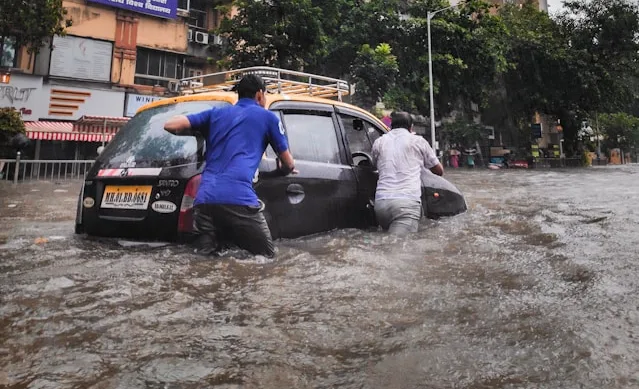Heavy rainfall and overflowing rivers worsen Gujarat’s flood crisis; Vadodara worst hit
Gujarat is grappling with an intense flood crisis as torrential rainfall continues to batter the state for the fourth consecutive day. Vadodara, one of the worst-affected cities, has witnessed severe flooding, with some areas submerged under 10 to 12 feet of water. The situation has prompted the state government to enlist the Indian Army for urgent relief and rescue operations.
The relentless rains have claimed at least 28 lives across Gujarat in the past three days. Approximately 40,000 people have been evacuated from flood-prone areas to safer locations, according to Alok Kumar Pandey, the state relief commissioner. The India Meteorological Department (IMD) has issued a red alert for exceptionally heavy rainfall in parts of the Saurashtra region, intensifying the crisis.
Embed from Getty ImagesVadodara has been particularly hard-hit. The Vishwamitri River, which flows through the city, breached its banks due to the torrential rainfall and the release of water from the Ajwa Dam. The river surpassed its danger mark of 25 feet, reaching 37 feet by Tuesday morning, leading to widespread inundation of residential areas, roads, and vehicles.
State Health Minister Rushikesh Patel reported that low-lying parts of Vadodara are experiencing severe flooding, with some areas submerged under 10 to 12 feet of water. In response, the gates of the Ajwa Dam have been closed to prevent further water flow into the already overflowing Vishwamitri River. So far, over 5,000 people have been evacuated, and another 1,200 have been rescued in Vadodara alone.
Prime Minister Narendra Modi has contacted Chief Minister Bhupendra Patel to review the situation and offer central government support. The Chief Minister has requested additional resources, including five National Disaster Response Force (NDRF) teams and four Army columns, to tackle the crisis. Rescue boats from Ahmedabad and Surat have been deployed to Vadodara.
The floods have also led to significant fatalities across several districts, including Rajkot, Anand, Mahisagar, Kheda, Ahmedabad, Morbi, Junagadh, and Bharuch. In Morbi district, seven out of eight people missing after a tractor trolley was swept away by floodwaters have been found. However, a six-year-old girl remains unaccounted for. Other casualties include three family members who drowned after their car was swept away in Rajkot.
Gujarat has received 934.49 mm of rainfall so far, which is 105% of its annual average. Saurashtra districts, such as Devbhumi Dwarka, Jamnagar, Rajkot, and Porbandar, experienced heavy rainfall, ranging from 50 mm to 200 mm in a 12-hour period. The state’s emergency operations centre reported that 140 reservoirs and dams, along with 24 rivers, are flowing above danger levels.
Transportation has been severely impacted by the flooding, with railway tracks submerged, leading to the cancellation of 48 trains. Another 14 trains have been partially cancelled, six short-terminated, and 23 diverted. The flooding has also disrupted road traffic, further complicating rescue and relief efforts.
Analysis:
Political: The ongoing flood crisis in Gujarat has political ramifications as it challenges the state government’s crisis management and disaster response capabilities. The involvement of the Indian Army and National Disaster Response Force highlights the scale of the emergency and the need for effective governance in managing natural disasters. The central government’s response, including Prime Minister Modi’s involvement, reflects the critical nature of the situation and could influence political perceptions of the state and central authorities’ efficiency in handling crises.
Social: Socially, the floods have caused widespread displacement and suffering. The evacuation of 40,000 people and the reported deaths highlight the human cost of the disaster. The affected communities face dire conditions, including lack of access to basic necessities and healthcare. The crisis may lead to long-term social impacts, including displacement and psychological trauma among survivors. The response from humanitarian organizations and local communities will be crucial in addressing immediate needs and providing support.
Racial: While the immediate racial implications are not pronounced, the impact of the floods on marginalized communities could exacerbate existing disparities. Vulnerable populations, including lower-income groups, may be disproportionately affected by the flooding, facing greater challenges in accessing relief and recovery resources. Addressing these disparities will be important for ensuring equitable support during the crisis.
Gender: The gendered impact of the floods could be significant, as women and children are often more vulnerable during natural disasters. The displacement and disruption caused by the floods can affect women’s access to health services, including reproductive health care, and exacerbate gender-based violence. Ensuring that relief efforts address these gender-specific needs is essential for a comprehensive response.
Economic: The economic impact of the floods is substantial, with disruptions to transportation, loss of property, and damage to infrastructure. The cancellation of trains and the flooding of roads affect logistics and commerce, potentially leading to economic losses. The costs of relief and recovery operations, along with the damage to homes and businesses, will strain the state’s resources and could have long-term economic implications for the region.
